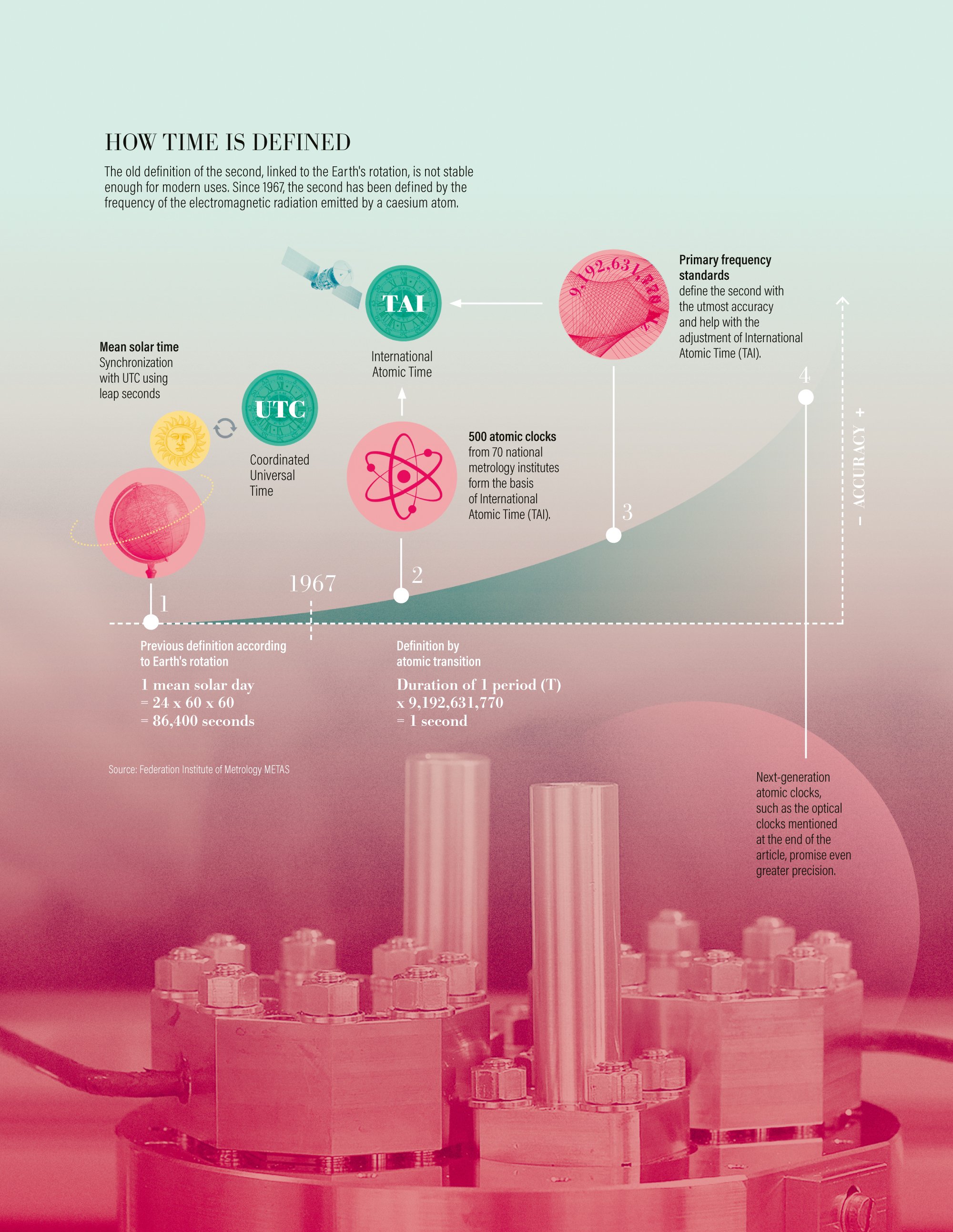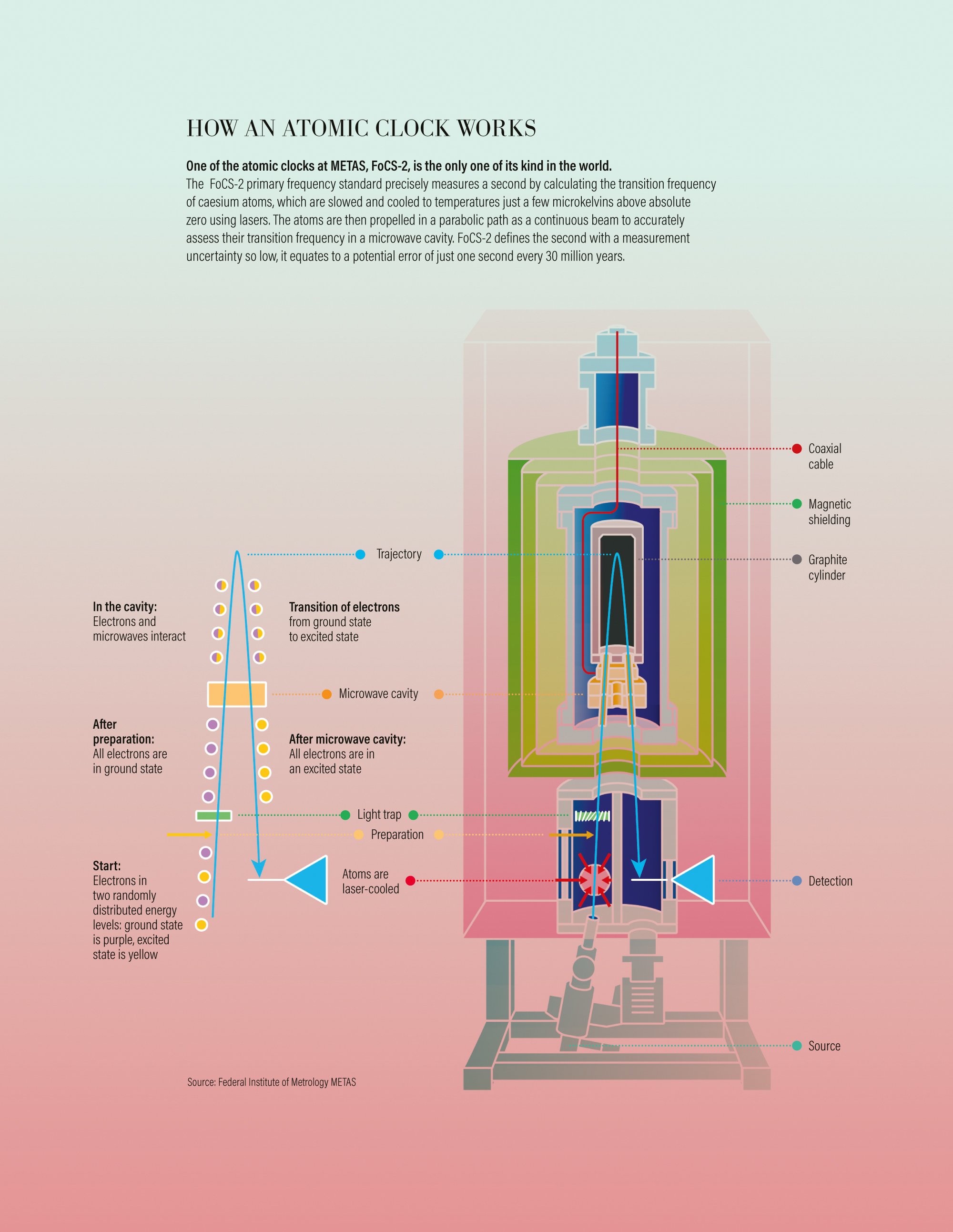t the third stroke, the time will be 23 hours, 59 minutes and 59 seconds…” On July 1, 2022, France retired its speaking clock after 89 years of loyal service. Switzerland’s national telecom operator Swisscom continues to provide its speaking clock service, which was called more than a million times in 2016 (last available figure).
The job of maintaining the exact time falls to the International Bureau of Weights and Measures (known by its French acronym, BIPM), which is based just outside Paris, in Saint-Cloud. Since 1875 the BIPM has been the official guardian of the fundamental units with which we measure the world. It defines the metre, the second and the kilogram, and coordinates the work of metrologists worldwide. It also broadcasts Coordinated Universal Time (UTC) – the “official” time – with a mindblowing accuracy of one tenth of a billionth of a second per day.
An accurate time signal is essential in fundamental research, as well as for numerous technologies such as global satellite navigation systems, telecommunications, energy networks and financial markets. For example, financial transactions in Europe are timestamped to one ten-thousandth of a second.
Paris time
The history of accurate time signals takes us from the French Revolution all the way to the stars and atoms. The BIPM was founded in 1875 to house the prototypes for the metre and the kilogram. It marked the culmination of a process that began in the wake of the French Revolution, to simplify the hundreds of units of measurement then in use, using multiples of ten. This gave rise to kilograms and kilometres, decilitres and milliseconds, and, more recently, terrawatt-hours and petabytes.
In the nineteenth century, the unit of time was defined by the astronomical day, which is the time Earth takes to complete one revolution on its axis. One second equals 1/86,400 of a day (24 hours, with one hour equal to 60 minutes and one minute equal to 60 seconds). Astronomical observatories provided this information by recording the time at which distant stars returned to the same position in the sky.
Because the Earth’s rotation is not completely stable, the day loses a few seconds every century. Consequently, in 1960 the BIPM redefined the second as a fraction of the solar year, which is longer and more consistent.

Atomic time
This new definition would be shortlived. In 1967 the second was given its current definition, based on the vibration of an atom: an extremely stable phenomenon that is the basis for atomic clocks. “This was a sea change,” says Patrizia Tavella, director of the Time Department at the BIPM. “For the first time, the second was linked not to observations of the motion of the stars but to an independent and universal phenomenon which, in theory, could be reproduced in another galaxy.”
An atomic clock monitors the frequency of an electromagnetic wave against the change in energy states of a collection of atoms. For caesium, this frequency is 9,192,631,770 Hz, and it defines the second as the time taken to count 9,192,631,770 vibrations. Like a mechanical or quartz watch, the succession of seconds measured by atomic clocks defines the official time.
The BIPM establishes UTC by averaging the time signals provided by more than 450 atomic clocks at 89 metrological institutes in 65 countries. This is why, notes Patrizia Tavella, official time is a consensus.
Even so, astronomical time isn’t completely obsolete. UTC is regularly “slowed down” by adding one second, to stay more closely aligned with the Earth’s rotation. However, this leap second could be retired in 2035 (see following pages).
Last month’s time
Until the 1980s, atomic clocks were physically transported for comparison and synchronisation. This is now done thanks to a satellite geolocation system such as the United States’ GPS or the European Union’s Galileo. These satellites – essential for positioning to within a few metres – carry atomic clocks which laboratories use to synchronise by comparing time signals and sending the difference to the BIPM.
Averaging 89 atomic times increases accuracy but takes… time, hence the BIPM uses local times, defined by metrological institutes, as a reference. Each month it publishes the offset between UTC and these local times. Coordinated Universal Time is therefore not available in real time: we know what the exact time was… last month!
The official time in Switzerland – UTC(CH) – is defined by the Swiss Federal Institute of Metrology (METAS) and is offset from UTC by just a few nanoseconds. “Each day we compare our time signals and make corrections to minimise the offset with UTC,” explains METAS research scientist Antoine Jallageas. UTC(CH) is used by research and industry, as well as to calibrate clocks via satellite or with a reference instrument. This official time is broadcast free of charge online, although network delay impacts its one millisecond accuracy.

A temporal fountain
METAS’s five atomic clocks – four caesium and one hydrogen – are housed in a controlled environment with minimal risk of interference from vibrations, electromagnetic fields or temperature change. Target accuracy of 0.0000000000001% (1e-15) means that extremely low intensity physical effects are taken into consideration: thermal radiation, time dilation due to the difference in gravitational pull at the top and bottom of the clock (Einstein’s theory of relativity) and the Doppler effect due to the relative motion of atoms.
One of the atomic clocks at METAS, FoCS-2, is the only one of its kind in the world. “It is the only one validated to define the primary frequency standard [the equivalent of the second] using a continuous beam of laser-cooled caesium atoms, known as a fountain,” Antoine Jallageas explains.
“This alternative approach means we can have greater confidence in the second defined by metrology institutes around the world.” Development of FoCS-2 began in the late 1990s at the University of Neuchâtel. METAS has been collaborating with the university for many decades. “Neuchâtel Observatory played a leading role in international chronometry,” notes Jürg Niederhauser, head of corporate affairs at METAS. “Neuchâtel is home to numerous watchmaking companies and in 1853 the Swiss Federal Council tasked the observatory with defining an accurate official time.” The observatory went on to become a reference in precision timekeeping, not least for the international chronometry trials which took place there. This tradition continues at University of Neuchâtel’s Time and Frequency Laboratory, which develops atomic clocks including small-scale clocks for spacecraft.
One second in 30 billion years
Currently, the most accurate atomic clocks, which function with caesium, are accurate to 8 picoseconds per day – a variation of one second in 300 million years. However, as Sébastien Bize, head of Optical Frequency Metrology research at the Paris Observatory, points out, these limits are already being exceeded by instruments that use strontium or ytterbium, which vibrate at a much higher frequency than caesium.
The major benefit of these optical clocks is that they are between ten and one hundred times more accurate than caesium clocks. This is because, the more oscillations there are to be counted within each second, the lower the relative error if some of the oscillations are not counted. The second advantage is that the signal they produce is already the correct frequency for transmission via fibre optics, whereas the signal from a caesium clock has to be converted. “There is no point keeping a signal to yourself,” insists Sébastien Bize. “The objective is to provide reference signals. Also, metrology works by averaging the signals from different laboratories, which means they have to be shared. The fact that we can send these signals through fibre optical cables is a huge step forward.”
These new generations of clocks have already achieved a phenomenal accuracy of one second in 30 billion years, which is twice the age of the universe. If their accuracy, reliability and robustness can be confirmed, they will be integrated into the calculation of UTC broadcast by the International Bureau of Weights and Measures: that venerable institution which, for a century and a half, has been keeping the world on time.




















